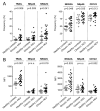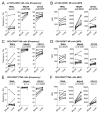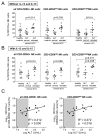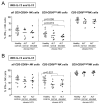Natural killer cells are polarized toward cytotoxicity in chronic hepatitis C in an interferon-alfa-dependent manner
- PMID: 19747917
- PMCID: PMC2862622
- DOI: 10.1053/j.gastro.2009.08.066
Natural killer cells are polarized toward cytotoxicity in chronic hepatitis C in an interferon-alfa-dependent manner
Abstract
Background & aims: Patients with chronic hepatitis C virus (HCV) infection display great variability in disease activity and progression. Although virus-specific adaptive immune responses have been characterized extensively and found to be impaired in chronic hepatitis C, the role of innate immune responses in disease activity and progression of chronic hepatitis C is not well understood.
Methods: We studied 42 HCV-infected patients and 12 healthy uninfected controls.
Results: We found an increased frequency of natural killer (NK) cells expressing tumor necrosis factor-related apoptosis-inducing ligand (TRAIL), NKp44, NKG2C, and CD122 in chronic hepatitis C as compared with healthy controls (P < .05 for all markers) and stronger activation of NK cells in the liver than in the blood (P < .05). This NK cell phenotype was associated with polarization of NK cell function toward CD107a expression as a marker of degranulation, but with not increased interferon (IFN)-gamma production of CD56(dim) NK cells. The polarized NK cell phenotype correlated with alanine aminotransferase levels (r(2) = 0.312, P = .03). To investigate whether in vivo exposure of NK cells to HCV-induced type I IFN was causing this NK cell phenotype, peripheral blood mononuclear cells from 10 healthy controls and 8 HCV-infected patients were stimulated in the presence of IFN-alfa, which resulted in increased NK cell expression of TRAIL and CD107a (P < .001), but not IFN-gamma.
Conclusions: Collectively, these results describe a polarized NK cell phenotype induced by chronic exposure to HCV-induced IFN-alfa. This phenotype may contribute to liver injury through TRAIL expression and cytotoxicity, whereas the lacking increase in IFN-gamma production may facilitate the inability to clear HCV.
Copyright 2010 AGA Institute. Published by Elsevier Inc. All rights reserved.
Figures








Similar articles
-
Early changes in natural killer cell function indicate virologic response to interferon therapy for hepatitis C.Gastroenterology. 2011 Oct;141(4):1231-9, 1239.e1-2. doi: 10.1053/j.gastro.2011.06.069. Epub 2011 Jul 7. Gastroenterology. 2011. PMID: 21741920 Free PMC article.
-
Early changes in interferon signaling define natural killer cell response and refractoriness to interferon-based therapy of hepatitis C patients.Hepatology. 2012 Jan;55(1):39-48. doi: 10.1002/hep.24628. Epub 2011 Nov 14. Hepatology. 2012. PMID: 21898483 Free PMC article. Clinical Trial.
-
Expansion of functionally skewed CD56-negative NK cells in chronic hepatitis C virus infection: correlation with outcome of pegylated IFN-alpha and ribavirin treatment.J Immunol. 2009 Nov 15;183(10):6612-8. doi: 10.4049/jimmunol.0901437. Epub 2009 Oct 21. J Immunol. 2009. PMID: 19846870
-
Control of HCV Infection by Natural Killer Cells and Macrophages.Cold Spring Harb Perspect Med. 2020 Sep 1;10(9):a037101. doi: 10.1101/cshperspect.a037101. Cold Spring Harb Perspect Med. 2020. PMID: 31871225 Free PMC article. Review.
-
Natural killer cells in hepatitis C: Current progress.World J Gastroenterol. 2016 Jan 28;22(4):1449-60. doi: 10.3748/wjg.v22.i4.1449. World J Gastroenterol. 2016. PMID: 26819513 Free PMC article. Review.
Cited by
-
Opposing Functions of Interferon Coordinate Adaptive and Innate Immune Responses to Cancer Immune Checkpoint Blockade.Cell. 2019 Aug 8;178(4):933-948.e14. doi: 10.1016/j.cell.2019.07.019. Cell. 2019. PMID: 31398344 Free PMC article.
-
Immunomodulation of Natural Killer Cell Function by Ribavirin Involves TYK-2 Activation and Subsequent Increased IFN-γ Secretion in the Context of In Vitro Hepatitis E Virus Infection.Cells. 2023 Jan 31;12(3):453. doi: 10.3390/cells12030453. Cells. 2023. PMID: 36766795 Free PMC article.
-
Hepatitis C virus (HCV) evades NKG2D-dependent NK cell responses through NS5A-mediated imbalance of inflammatory cytokines.PLoS Pathog. 2010 Nov 11;6(11):e1001184. doi: 10.1371/journal.ppat.1001184. PLoS Pathog. 2010. PMID: 21085608 Free PMC article.
-
STAT4-associated natural killer cell tolerance following liver transplantation.Gut. 2017 Feb;66(2):352-361. doi: 10.1136/gutjnl-2015-309395. Epub 2016 Feb 17. Gut. 2017. PMID: 26887815 Free PMC article.
-
Effect of recombinant cytokines on the expression of natural killer cell receptors from patients with TB or/and HIV infection.PLoS One. 2012;7(6):e37448. doi: 10.1371/journal.pone.0037448. Epub 2012 Jun 8. PLoS One. 2012. PMID: 22715368 Free PMC article. Clinical Trial.
References
-
- Rehermann B, Nascimbeni M. Immunology of hepatitis B virus and hepatitis C virus infection. Nat Rev Immunol. 2005;5:215–29. - PubMed
-
- Chang KM, Thimme R, Melpolder JJ, Oldach D, Pemberton J, Moorhead-Loudis J, McHutchison JG, Alter HJ, Chisari FV. Differential CD4 and CD8 T-cell responsiveness in hepatitis C virus infection. Hepatology. 2001;33:267–276. - PubMed
-
- Lauer GM, Barnes E, Lucas M, Timm J, Ouchi K, Kim AY, Day CL, Robbins GK, Casson DR, Reiser M, Dusheiko G, Allen TM, Chung RT, Walker BD, Klenerman P. High resolution analysis of cellular immune responses in resolved and persistent hepatitis C virus infection. Gastroenterology. 2004;127:924–36. - PubMed
Publication types
MeSH terms
Substances
Grants and funding
LinkOut - more resources
Full Text Sources
Other Literature Sources
Research Materials

